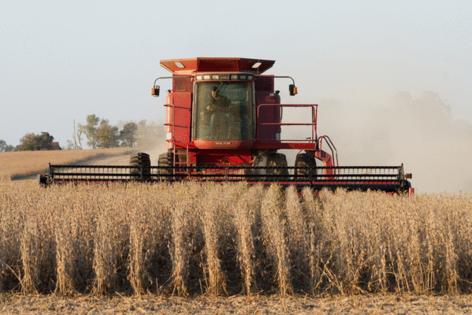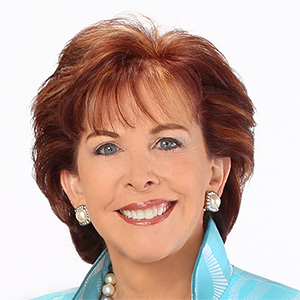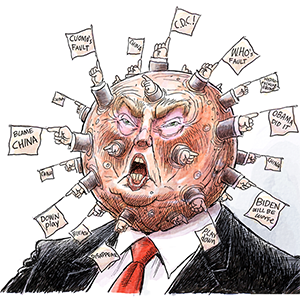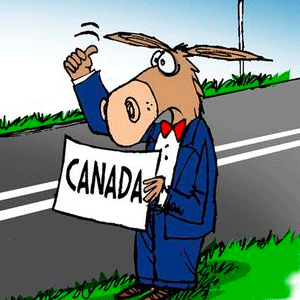Trump tariffs hit Missouri farmers hard. 'That's going to come out of my pocket'
Published in Business News
Blake Hurst has had a lot to worry about lately. A third-generation soybean, corn and flower farmer in northwestern Missouri, he is currently planting crops.
But commodity prices have been low, droughts have turned his fields to dust and now, he said, new tariffs threaten to disrupt his family business.
Since stepping into office, President Donald Trump’s on-again, off-again tariff policies have hit farmers and producers from multiple sides. Equipment and material costs have gone up and farmers are now unsure who will buy their crops and if they’ll make a profit.
“I can’t emphasize enough how this uncertainty is extraordinarily expensive for anybody trying to make decisions for business,” Hurst said of Trump’s trade policies. “Every day, people put their money down on what they think is going to happen.”
Currently, the U.S. has levies on steel and aluminum products, auto parts, products from Canada, Mexico and China and a baseline 10% universal duty on all imported goods — with more possible. The goal, Trump has said, is to increase domestic jobs and production.
Trump has gone back and forth on retaliatory tariff increases with China — a major buyer of American soybeans and a big seller of farm equipment. Most recently, he imposed a 145% tariff on Chinese goods, to which China responded by placing a 125% levy on American goods.
Hurst said he now can’t afford to replace old tractors or combines, buy his usual potash fertilizer from Canada or order his annual shipping container of planters from China.
“I have no idea how I’m going to source those. I can’t afford to pay 145% tariffs,” Hurst said. “I wish I could buy my pots next door, but I can’t. I’ve got one place to get them, and that place is no longer successful, so I don’t know what we’re going to do.”
The lack of specifics about tariffs make it difficult to plan for his 1,400-acre farm, about two hours north of Kansas City in the town of Westboro, Hurst said. Even though commodity prices could look different or a new trade deal could be in place by harvest time, farmers need answers as they plant now, he said.
And more changes could happen in the coming days. U.S. and China are expected to hold trade talks Saturday through Monday in Switzerland.
In the red
Rural communities rallied behind Trump as he sought a second term by promising support and monetary aid to smaller scale and family farms. According to data from Investigate Midwest, farming-dependent counties across the country overwhelmingly voted for Trump in 2024 by about 78%. In Missouri, Trump won all but four of the state’s 115 counties.
Trump has touted tariffs as a way to onshore manufacturing and production, protect American workers and stop migrants and illegal drugs from entering the U.S. In a March 3 social media post, Trump addressed “the great farmers of the United States.”
“Get ready to start making a lot of agricultural product to be sold INSIDE of the United States,” he wrote.
Missouri is the ninth-largest agricultural exporting state in the U.S., shipping $6.1 billion in domestic agricultural exports to places like Mexico, Canada and countries in Asia in 2022, according to the Office of the U.S. Trade Representative.
It’s been a few lean decades when it comes to farming profits, said Tim Gibbons, former communications director for the Missouri Rural Crisis Center, a non-profit advocacy group in Columbia.
Between 2017 and 2022, Missouri lost 7,433 farms and 10,000 cattle operations due to high operating costs and low market prices, according to the U.S. Department of Agriculture.
Interest rates jumped following the COVID-19 pandemic, when the Federal Reserve began a series of hikes that moved rates from 0.33% in early 2022 to 5.33% in July 2023.
This month, soybean prices sit at $10.40 per bushel, which is almost two dollars less than it was this time last year. Wheat prices also dropped by about $2 and corn is about 40 cents less per bushel compared to last May.
Soybeans are a paramount player for Missouri. It’s a versatile crop: It can feed livestock, produce seed oil and be turned into fuel. About $2.3 billion worth of soybeans were exported in 2022. Most of it goes to China, the world’s largest importer of the legume, which received over 105 million tons of soybeans last year.
Tariffs and trade policy affect multiple business sectors, but the agricultural industry doesn’t have the ability to quickly switch up its strategies like other businesses might, said Mike Steenhoek, executive director of the Soy Transportation Coalition. So, he’s recommending farmers diversify where they sell, rather than try to plant different crops.
“If China is a home-run market, which it is, a success in the future for us will involve more and more finding the base-hit markets that means some of the other smaller markets around the world,” Steenhoek said. “But you can win baseball games via base hits.”
Hurst, the farmer, said that about a quarter of his entire crop yield gets sent to China, so he doesn’t know what he’ll do if China doesn’t accept the goods. He said he’ll probably have to ship to South America, another major soybean producer.
“Some of Brazil’s customers will now be our customers, and China will buy from Brazil,” Hurst said. ”Clearly, it’s more inefficient and will cost more, and that’s going to come out of my pocket.”
In early April, Missouri U.S. Sen. Josh Hawley said that Trump would look out for American farmers amid tariff increases. In his first term, Trump unveiled $16 billion in aid for farmers who had been hurt under the U.S. trade war with China.
“The President has said that he will absolutely compensate farmers if our farmers get targeted by, say, China or other competitors who try to take out retaliation on our farmers,” Hawley told Fox 2 in an interview. “The Trump administration has been clear: They’re going to protect American farmers, and that begins with Missouri farmers, and I intend to hold the President to his word on that.”
Hawley’s office did not immediately respond for a request for comment.
Darvin Bentlage, a fourth-generation cattle and grain farmer in Lawrence County, recently penned an op-ed on how Missouri farmers can’t withstand another round of Trump tariffs, because many are still feeling the effects of the tariffs imposed under Trump’s first term.
Bentlage runs a 120-acre farm with 40 beef cattle. He used to operate 1,200 acres, half planted with row crops like soybeans, wheat and corn and the other half as pasture and hay fields for cows. He recently downsized.
In 2018, U.S. soybean exports to China dropped by 75% amid trade tensions, according to the U.S. International Trade Commission. And producers say the U.S. still has yet to win back some of those markets.
Bentlage remembers how high prices got under the tariffs of Trump’s first term. A part he needed for a mower machine jumped from $9,500 to $12,000.
“Luckily, I had a lot of equity in my farm and so I just went about paying for it again,” Bentlage said. He and his wife retired from the “big farm” about a year and a half ago to avoid “going through it again.”
Though farmers won’t see the result of Trump’s levies on grain prices until harvest time in the fall, Bentlage said he’s concerned about operating costs now and what uncertainty about tariffs means for the future of American farmers.
“We’re becoming an untrustworthy and unreliable trade partner and we’ve got too much competition, especially in agriculture out there,” Bentlage said. “It’s not real positive, especially for newer guys starting out, so it’ll be difficult.”
©2025 STLtoday.com. Distributed by Tribune Content Agency, LLC.












Comments